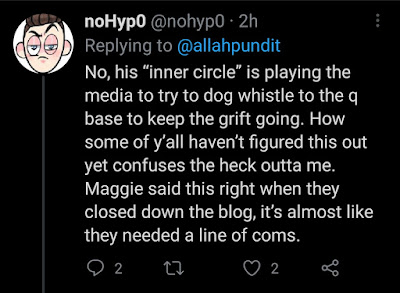In 2019 I noted that there seemed to be a clear lack of detailed academic commentary on Bruce Pascoe's Dark Emu, with the only criticism coming from Right wing polemicists who obviously have some culture war axes to grind. Nonetheless, I suspected they were correct - and my theory was that the Lefty world of academia was remaining silent rather than being seen as aligned with the world of Andrew Bolt and Quadrant.
Well, at last, it appears that the world of professional academic anthropology has finally broken their silence. See this article in Good Weekend today, about a new book by two long established anthropologists.
Perhaps I was unfair in thinking the academics were being silent because of political correctness - it would seem that they just didn't think a book by an amateur historical revisionist was worth looking into with much urgency - which is unfortunate, give that the cultural fashion world of educationalist academia was rushing to endorse it and see it promoted within classrooms. Some extracts:
It was not until 2019, when Dark Emu had taken on a
celebrated status, that Sutton gave it his full attention. He was deeply
unimpressed, as he was when he read Bruce Chatwin’s The Songlines,
the 1987 bestseller combining fiction and non-fiction which popularised
the notion of Aboriginal people singing the stories of the land,
without much understanding of Aboriginal culture. Nothing in Sutton’s 50
years of research with senior Aboriginal people suggested to him that
Pascoe was right. He was “disturbed” that Pascoe’s descriptions of
Aboriginal life were based on – and to his mind, took liberties with –
“the journals of blow-through European explorers, men who were ignorant
of the languages and cultures of those they met”, rather than Aboriginal
people, whose knowledge has been recorded for the past hundred years at
least.
He was “disappointed” that in attempting to describe
Aboriginal land use, Pascoe ignored the importance of spiritual
tradition and ritual. He was “stunned” that the book was “riddled with
errors of fact, selective quotations, selective use of evidence, and
exaggeration of weak evidence”, including the suggestion Aboriginal
people have occupied Australia for 120,000 years. And he was “outraged”
that school curricula were being changed to conform with the Dark Emu narrative, embracing Pascoe’s descriptions of an early agricultural society.
And clearly, this criticism is from a Left perspective - that Pascoe, by trying to re-classify aboriginal society as an agricultural one, was actually buying into conservative views:
More than anything, he felt that Pascoe had done the Old People – as
Sutton refers to them – a monumental disservice, resurrecting
long-discredited ideas of social evolutionism that placed
hunter-gatherers lower on the evolutionary scale than farmers. To
Sutton, it was a rebirthing of the colonial philosophy used to justify
Aboriginal dispossession in the first place: that people who lived
lightly on the land had no claim to it, that farmers were more deserving
of dignity and respect than hunter-gatherers.
More important to me is the specific criticisms of misleading dishonestly in the book, many of which had been raised by those Right wing polemicists, and are confirmed as correct. (I always suspected they would be, because no one was coming out and showing the factual errors in the Right wing attacks.)
Pascoe records Mitchell’s astonishment on coming upon a large,
deserted village during his Australia Felix expedition, which he
estimated housed “over 1000” people. This, says Sutton, is “pure
fiction”. “All Mitchell says is that his party ‘noticed some of their
huts’; there is no mention of anyone counting anything.” Pascoe then
quotes a member of Mitchell’s party, Granville Stapylton, as saying that
the buildings “were of very large dimensions, one capable of containing
at least 40 persons and of very superior construction”. But he omits
Stapylton’s speculation that this was “the work of a white man”,
probably the runaway convict William Buckley, who lived with the
Wathaurong people for three decades.
Elsewhere, Pascoe cites
Charles Sturt’s discovery of a large well and village somewhere north of
Lake Torrens in South Australia, but neglects to say that Sturt saw no
signs of recent occupation. When Sturt finds grass set out to dry and
ripen, Pascoe guesses this was because of surplus grain, which suggested
“sedentary agriculture”. Sutton ridicules the idea. “The suggestion, if
that is what Pascoe intends, that anyone could practise ‘sedentary
agriculture’ in that blasted desert environment is simply ill-informed,”
he writes.....
Over 300 pages, Sutton and Walshe pick apart Dark Emu. Where
Pascoe writes that permanent housing was “a feature of the pre-contact
Aboriginal economy and marked the movement towards agricultural
reliance”, Sutton dismisses this absolutely. “The recurring pattern, all
over Australia, was one of seasonal and other variation in lengths of
stays in one place,” Sutton writes. “No group is ever described, at the
moment of colonisation, as living year in, year out, in one single
place.” Where Dark Emu featured the use of stone for housing,
Sutton answers that it was “the rarest in the Aboriginal record”, a
“last resort” in the stoniest of environments.
And so on.
I expect that there are a dozen or so broadcasters from the ABC who will need the smelling salts after reading about this this book - Patricia Karvelas and Jonathan Green especially. They have shown a complete lack of interest in checking whether any form of criticism of Pascoe and his books had some truth or validity.
The Labor Party needs to be particularly careful about this. I reckon there is a political price to be paid for showing too much credulity to pro-indigenous claims and politics. The lesson of the Hindmarsh Island scandal seems to have faded too quickly from their consciousness.
Update: The Conversation features as positive review of the new book.














